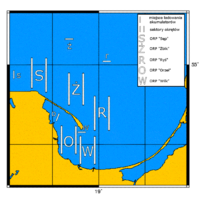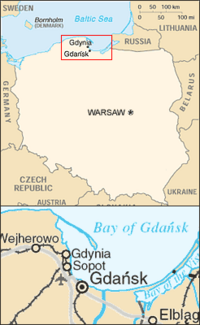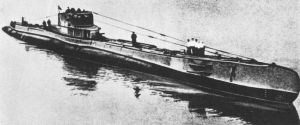
Worek Plan
Encyclopedia


Polish Navy
The Marynarka Wojenna Rzeczypospolitej Polskiej - MW RP Polish Navy, is the branch of Republic of Poland Armed Forces responsible for naval operations...
in the first days of World War II
World War II
World War II, or the Second World War , was a global conflict lasting from 1939 to 1945, involving most of the world's nations—including all of the great powers—eventually forming two opposing military alliances: the Allies and the Axis...
, in which its five submarine
Submarine
A submarine is a watercraft capable of independent operation below the surface of the water. It differs from a submersible, which has more limited underwater capability...
s formed a screen in order to prevent German naval forces
Kriegsmarine
The Kriegsmarine was the name of the German Navy during the Nazi regime . It superseded the Kaiserliche Marine of World War I and the post-war Reichsmarine. The Kriegsmarine was one of three official branches of the Wehrmacht, the unified armed forces of Nazi Germany.The Kriegsmarine grew rapidly...
from carrying out landings on the Polish coast, and to attack enemy ships bombarding Polish coastal fortifications, in particular the fortified Hel Peninsula
Hel Peninsula
Hel Peninsula |Nehrung]]) is a 35-km-long sand bar peninsula in northern Poland separating the Bay of Puck from the open Baltic Sea. It is located in Puck County of the Pomeranian Voivodeship.- Geography :...
.
The operation came to naught, as the Germans did not have any plans for naval landings. It caused the submarines to operate in a confined area near the shore in shallow waters, making them vulnerable to strong enemy anti-submarine forces. As a result, despite making a number of attempts, the submarines were unable to directly sink any enemy ships during the operation, although a mine placed by the Żbik
ORP Zbik
ORP Żbik was a which saw service in the Polish Navy from 1932 to 1955. Her name means "wildcat" in Polish.Żbik was laid down in 1927 in Caen, launched in 1930, and entered service in 1932. When World War II began on 1 September 1939, she took part in the Worek Plan for the defense of the Polish...
did sink a German minesweeper
Minesweeper (ship)
A minesweeper is a small naval warship designed to counter the threat posed by naval mines. Minesweepers generally detect then neutralize mines in advance of other naval operations.-History:...
. No Polish submarines were lost to enemy action, but they suffered progressive wear and tear, and technical problems, forcing the submarine commanders to break off their actions, effectively ending the operation by the middle of September 1939.
The Plan
The plan was created for the five Polish submarines OrzełORP Orzeł
Three boats of the Polish Navy have been named ORP Orzeł :* ORP Orzeł was an commissioned in 1939 and lost in 1940.* ORP Orzeł was a commissioned in 1962 and decommissioned in 1983....
(Eagle), Wilk
ORP Wilk
ORP Wilk was the lead boat of her class of mine-laying submarines of the Polish Navy. The ship saw service in the Polish Navy from 1931 to 1951. Her name meant "Wolf" in Polish.-History:...
(Wolf), Sęp
ORP Sep
For the second ORP Sęp serving in the Polish Navy since 2002, see ORP Sęp .ORP Sęp was a serving in the Polish Navy during World War II. In Polish her name means Vulture.-Construction:...
(Vulture), Żbik
ORP Zbik
ORP Żbik was a which saw service in the Polish Navy from 1932 to 1955. Her name means "wildcat" in Polish.Żbik was laid down in 1927 in Caen, launched in 1930, and entered service in 1932. When World War II began on 1 September 1939, she took part in the Worek Plan for the defense of the Polish...
(Wild Cat) and Ryś
ORP Rys
ORP Ryś was a which saw service in the Polish Navy from 1931 to 1955. Her name meant Lynx in Polish.-History:Ryś was laid down in 1927 in Nantes, France; launched in 1929; and entered service in 1932. When World War II began on September 1, 1939, she took part in the Worek Plan for the defense...
(Lynx) to use, in the event superior enemy surface forces took control of the Baltic Sea (the Polish surface navy consisted only of four destroyer
Destroyer
In naval terminology, a destroyer is a fast and maneuverable yet long-endurance warship intended to escort larger vessels in a fleet, convoy or battle group and defend them against smaller, powerful, short-range attackers. Destroyers, originally called torpedo-boat destroyers in 1892, evolved from...
s and some minelayers).
The submarines were to operate near the Polish coast, in the area of the Bay of Gdańsk and the Hel Peninsula
Hel Peninsula
Hel Peninsula |Nehrung]]) is a 35-km-long sand bar peninsula in northern Poland separating the Bay of Puck from the open Baltic Sea. It is located in Puck County of the Pomeranian Voivodeship.- Geography :...
. They were to engage enemy ships shelling the Polish coast or attempting to land forces on it. The plan explicitly stated that the submarines were to act according to international law
International law
Public international law concerns the structure and conduct of sovereign states; analogous entities, such as the Holy See; and intergovernmental organizations. To a lesser degree, international law also may affect multinational corporations and individuals, an impact increasingly evolving beyond...
, and single, unarmed ships had to be warned before being attacked.
Orzeł was to take the position furthest inside Gdańsk Bay, from Jastarnia
Jastarnia
Jastarnia is a small town in Puck County, Pomeranian Voivodship, northern Poland. It is located on the Hel Peninsula on the Baltic Sea. Popular Polish seaside resort and small fishing port....
to the estuary of the Vistula
Vistula
The Vistula is the longest and the most important river in Poland, at 1,047 km in length. The watershed area of the Vistula is , of which lies within Poland ....
river. East of Orzeł, in the entry to the Bay, was the place for Wilk. The remaining three submarines were to operate north of the Bay of Gdańsk : Sęp was further West near Rozewie
Rozewie
Cape Rozewie is a headland on the Baltic coast of Poland, in Pomeranian Voivodeship. It was formerly thought to be the most northerly point in Poland, but since measurements carried out in December 2000, that distinction is now given to a nearby beach in Jastrzębia Góra, marked by the "Northern...
, Ryś was further east, and Żbik in the middle. They had separate areas for recharging batteries during the night: Orzeł even deeper within the Bay of Gdańsk, and the other ships north of their positions.
Execution
The Worek Plan was put into action with the German invasion of Poland on 1 September 1939. Several hours after hostilities started, the submarines received communications by radio to open the envelopes containing orders to implement the Worek Plan. By the evening of the same day the last submarine (Sęp) arrived in its sector.All of the submarines attempted to engage the German forces, but they were all unsuccessful: German forces had numerical superiority and were supported by Luftwaffe
Luftwaffe
Luftwaffe is a generic German term for an air force. It is also the official name for two of the four historic German air forces, the Wehrmacht air arm founded in 1935 and disbanded in 1946; and the current Bundeswehr air arm founded in 1956....
units. Although the Polish submarines were frequently attacked with depth charges, none were destroyed. Eventually, after a series of failed attacks on both sides, the captains of the Polish submarines made individual decisions to abandon their sectors.
Aftermath

Estonia
Estonia , officially the Republic of Estonia , is a state in the Baltic region of Northern Europe. It is bordered to the north by the Gulf of Finland, to the west by the Baltic Sea, to the south by Latvia , and to the east by Lake Peipsi and the Russian Federation . Across the Baltic Sea lies...
n port of Tallinn
Tallinn
Tallinn is the capital and largest city of Estonia. It occupies an area of with a population of 414,940. It is situated on the northern coast of the country, on the banks of the Gulf of Finland, south of Helsinki, east of Stockholm and west of Saint Petersburg. Tallinn's Old Town is in the list...
for rest and repairs (international law allowed 24 hours before the ship was to be interned). The ship was seaworthy and after the Estonians attempted to take control of her, she escaped and reached the United Kingdom
United Kingdom
The United Kingdom of Great Britain and Northern IrelandIn the United Kingdom and Dependencies, other languages have been officially recognised as legitimate autochthonous languages under the European Charter for Regional or Minority Languages...
by 14 October: this event is known as the Orzeł incident. She was eventually sunk in 1940.
Ryś, damaged and unable to engage Germans units, eventually was interned in a Swedish port from 17 September.
Sęp was heavily damaged by a German destroyer on 2 September. She abandoned Plan Worek on the 4th and headed to Sweden, where she and her crew were interned from 17 September.
Wilk was the first Polish submarine to arrive in the United Kingdom; unlike Orzeł her captain decided not to dock at a continental port and risk internment, but to head straight for the British Isles, where Wilk arrived on 20 September. She survived the war.
Żbik was the only Polish submarine to succeed in sinking a German vessel during the campaign. On 1 October one of the mines she had laid sunk the German minesweeper
Minesweeper (ship)
A minesweeper is a small naval warship designed to counter the threat posed by naval mines. Minesweepers generally detect then neutralize mines in advance of other naval operations.-History:...
M-85. Increasingly damaged and low on provisions, she was interned in a Swedish port from 25 September.

